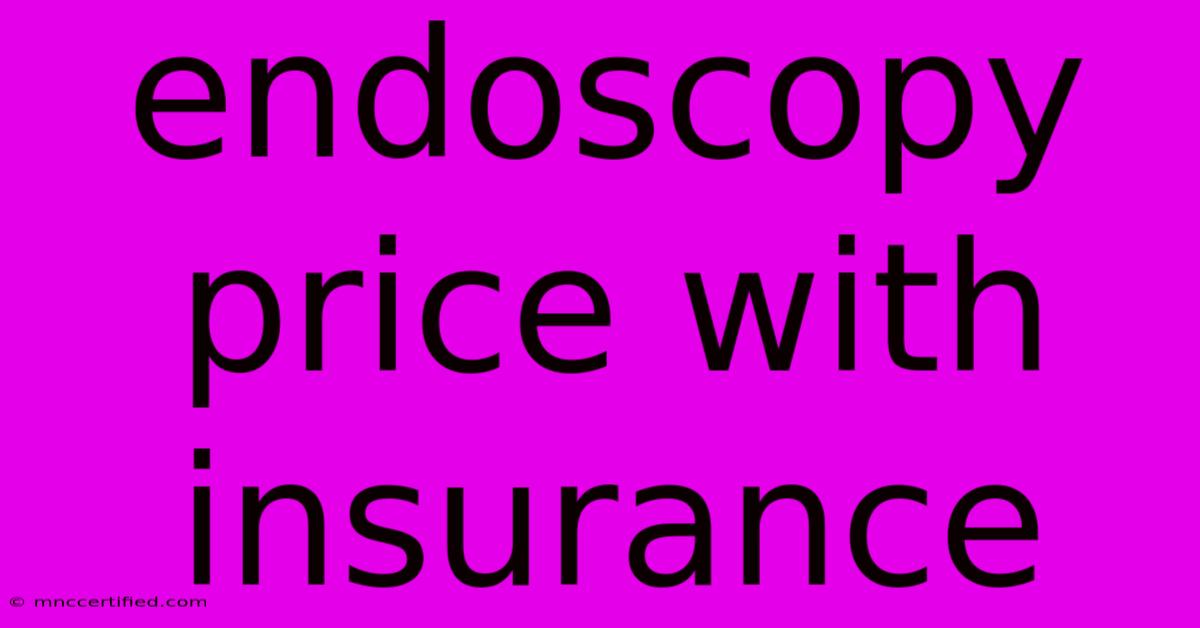Endoscopy Price With Insurance

Table of Contents
Endoscopy Price with Insurance: A Comprehensive Guide
Understanding the cost of an endoscopy, especially when factoring in insurance coverage, can be daunting. This comprehensive guide breaks down the price of endoscopy procedures, explains how insurance affects the final cost, and offers tips for navigating the financial aspects of this important medical procedure.
What is an Endoscopy?
An endoscopy is a medical procedure used to examine the internal organs of the body. A thin, flexible tube with a camera attached (endoscope) is inserted through a natural opening, such as the mouth or anus, to visualize the esophagus, stomach, small intestine, colon, or other areas. There are several types of endoscopy, including:
- Esophagogastroduodenoscopy (EGD): Examines the esophagus, stomach, and duodenum (the first part of the small intestine).
- Colonoscopy: Examines the large intestine (colon and rectum).
- Sigmoidoscopy: Examines the lower part of the large intestine (sigmoid colon and rectum).
Factors Affecting Endoscopy Price
The cost of an endoscopy can vary significantly depending on several factors:
- Type of Endoscopy: A colonoscopy is generally more expensive than a sigmoidoscopy, for example, due to the greater length of examination and preparation involved.
- Geographic Location: Costs vary widely based on location, with procedures in urban areas often being more expensive than those in rural areas.
- Facility Type: The cost will differ based on whether the procedure is performed in a hospital, outpatient surgery center, or doctor's office. Hospitals usually have higher overhead costs.
- Anesthesia: If general anesthesia is used, the cost will be higher than with conscious sedation or local anesthesia.
- Complexity of the Procedure: If biopsies are taken, polyps are removed, or other complications arise during the procedure, the cost can increase substantially.
- Physician Fees: The surgeon's experience and expertise also influence the overall cost.
How Insurance Impacts Endoscopy Costs
Most health insurance plans cover endoscopies, but the extent of coverage varies greatly. Here's what you should know:
- Deductible: You'll likely have to meet your annual deductible before your insurance begins to pay for the procedure.
- Copay: After meeting your deductible, you might still owe a copay for the procedure.
- Coinsurance: This is the percentage of the cost you're responsible for after meeting your deductible and paying your copay.
- Out-of-Pocket Maximum: Once you reach your out-of-pocket maximum, your insurance will usually cover 100% of the remaining costs.
- Network Providers: Using in-network providers (doctors and facilities your insurance company has a contract with) usually results in lower out-of-pocket expenses.
- Pre-authorization: Your insurance company might require pre-authorization before scheduling the procedure. Failing to obtain pre-authorization could lead to higher costs.
Understanding Your Insurance Policy
Before scheduling your endoscopy, it is crucial to:
- Contact your insurance provider: Verify your coverage for endoscopy procedures, including what your deductible, copay, and coinsurance are. Ask about pre-authorization requirements.
- Obtain an estimate: Ask your doctor's office or the facility where the procedure will be performed for a detailed cost estimate. This estimate should include all fees, including those for anesthesia, facility fees, and physician fees.
- Review your Explanation of Benefits (EOB): After the procedure, carefully review the EOB to ensure all charges are accurate and your insurance coverage was applied correctly.
Tips for Managing Endoscopy Costs
- Shop around: Compare costs from different facilities and providers.
- Negotiate: In some cases, it’s possible to negotiate the price of the procedure.
- Payment Plans: Explore payment plan options offered by the healthcare provider or facility.
- Financial Assistance Programs: Inquire about financial assistance programs offered by the hospital or your insurance company.
Conclusion
The cost of an endoscopy with insurance can vary greatly. Understanding your insurance coverage, obtaining cost estimates, and utilizing available resources are crucial steps in managing the financial aspects of this important procedure. By being proactive and informed, you can navigate the process more effectively and minimize unexpected expenses. Remember to always consult with your doctor and insurance provider for personalized guidance.

Thank you for visiting our website wich cover about Endoscopy Price With Insurance. We hope the information provided has been useful to you. Feel free to contact us if you have any questions or need further assistance. See you next time and dont miss to bookmark.
Featured Posts
-
Pediatric Dentist No Insurance
Nov 27, 2024
-
Team News Man City Vs Feyenoord
Nov 27, 2024
-
Insurance For A Clothing Store
Nov 27, 2024
-
Morgan Freeman 87 Looks Healthy
Nov 27, 2024
-
This Morning Star Sparks Ofcom Outrage
Nov 27, 2024